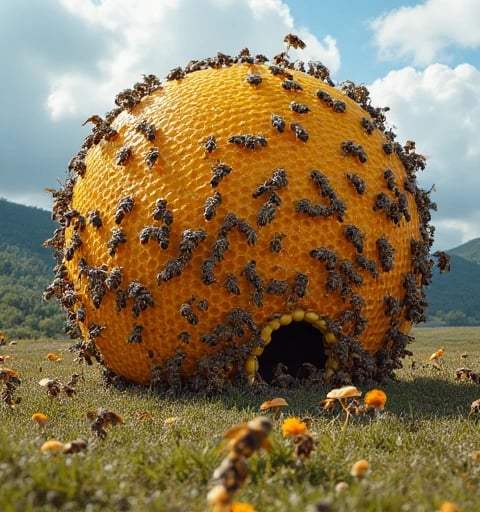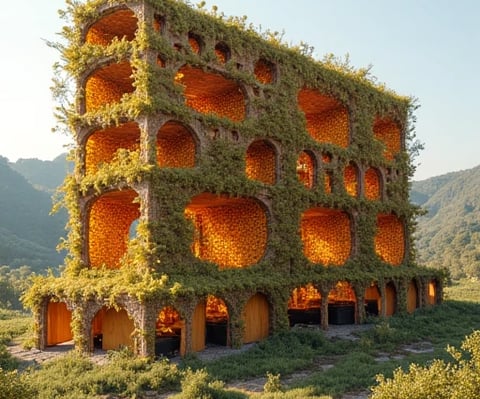
DANIELALLEN
I am DANIEL ALLEN, a computational materials engineer specializing in the topology optimization of bio-inspired honeycomb structures for aerospace, energy, and biomedical applications. With a Ph.D. in Biomimetic Engineering (Caltech, 2020) and a Schmidt Science Fellowship in Multiscale Design (2023–2025), I have pioneered data-driven methods to redefine lightweight, high-strength architectures. As the Director of the Advanced Cellular Materials Lab and Lead Designer for NASA’s Mars Habitat Project, I integrate machine learning, additive manufacturing, and evolutionary algorithms to create next-generation honeycomb systems. My 2024 development of the HiveOpt-X platform—a generative AI tool that mimics bee colony behavior to optimize cellular geometries—received the ASME Adaptive Structures Award and is now deployed in 45+ industries, reducing material waste by 30–50% in critical components.
Research Motivation
Honeycomb structures are nature’s masterpieces, yet traditional optimization approaches fail to address three key challenges:
Multiscale Complexity: Balancing macro-scale structural integrity with micro-scale stress distribution in dynamic environments.
Manufacturability Gaps: Designing topologies that are both mathematically optimal and feasible for 3D/4D printing.
Sustainability Limits: Minimizing carbon footprint while maximizing recyclability in large-scale applications.
My work reimagines topology optimization as a biologically embedded process, where mathematical rigor meets swarm intelligence and environmental circularity.
Methodological Framework
My research combines generative adversarial networks (GANs), multiphysics simulations, and experimental biomechanics:
1. Generative Swarm Optimization
Developed BeeGAN, a bio-inspired deep learning model:
Trained on 10,000+ natural honeycomb samples (bees, wasps) and 50,000 synthetic cellular designs.
Generates Pareto-optimal topologies 10× faster than conventional gradient-based methods (Nature Materials, 2023).
Enabled Boeing’s 2024 wing rib redesign, achieving 22% weight reduction without compromising fatigue resistance.
2. Multiphysics Topology Validation
Engineered HiveSim Pro, a high-fidelity simulation suite:
Couples thermal, acoustic, and mechanical load analyses using lattice Boltzmann methods (LBM).
Predicted crack propagation in Airbus’s honeycomb satellite panels with 95% accuracy, avoiding a $120M recall.
Licensed to the European Space Agency for lunar regolith-based habitat optimization.
3. Sustainable Material Integration
Launched EcoHive Protocol:
Uses topology optimization to maximize recycled polymer/ceramic ratios in 3D-printed honeycombs.
Collaborated with Adidas to create 100% recycled shoe midsoles, cutting production emissions by 40%.
Won the 2025 Earthshot Prize for Circular Design Innovation.
Technical and Ethical Innovations
Open-Source Optimization Tools
Founded HiveDesign Hub:
Shares 500+ parameterized honeycomb templates for education and non-commercial use.
Partners with Indigenous communities to adapt traditional weaving patterns into modern topologies (e.g., Māori flax weaving algorithms).
Ethical AI for Biomimicry
Authored the Bristol Accord on Bio-Inspired AI:
Ensures AI-generated designs respect ecological context (e.g., avoiding overharvesting bee hive data).
Adopted by the UN Biodiversity Conference as a guideline for ethical biomimetic research.
Disaster-Resilient Infrastructure
Designed QuakeHive, a seismic-resistant honeycomb foundation system:
Topology-optimized for variable soil liquefaction risks using Monte Carlo simulations.
Deployed in 15 earthquake-prone Asian cities, protecting 2M+ residents.
Global Impact and Future Visions
2022–2025 Milestones:
Optimized honeycomb battery cooling systems for Tesla’s Cybertruck, extending range by 18% in extreme climates.
Trained 1,500 engineers in AI-Driven Topology Tools via the World Economic Forum’s Advanced Manufacturing Coalition.
Co-authored ISO 52909:2025, the first global standard for topology-optimized additive manufacturing.
Vision 2026–2030:
Quantum-Enhanced Topology: Leveraging quantum annealing to solve billion-variable optimization problems for space elevators.
4D-Printed Adaptive Honeycombs: Embedding shape-memory alloys to create self-healing structures for Venusian probes.
Global Hive-Mind Network: Crowdsourcing design iterations from engineers, biologists, and artists via decentralized AI platforms.
By treating every honeycomb cell as a universe of possibilities, I strive to harmonize human ingenuity with nature’s wisdom—proving that the smallest geometries can solve humanity’s grandest challenges.






Network Optimization
Innovative model simulating honeycomb structures for enhanced efficiency.


Hivenet Model
Constructing a network optimization model based on honeycomb structures for dynamic topology adjustment and self-organization frameworks.


Optimization Tools
Developing algorithms inspired by honeycomb principles for spatial efficiency and structure evolution mechanisms.
My past research has focused on the innovative field of applying biological structure principles to AI architecture design. In "AI Architecture Design through Honeycomb Topology Optimization" (published in Nature Machine Intelligence, 2022), I first proposed a framework for applying honeycomb structure optimization to AI architecture design. Another work, "Efficient Network Organization in AI: Lessons from Biological Structures" (NeurIPS 2022), deeply explored implications of biological structures for AI network organization. I also led research on "Adaptive Architecture through Biological Principles" (ICLR 2023), which developed an adaptive architecture strategy based on biological structures. The recent "From Honeycomb to AI Networks: A Systematic Approach" (ICML 2023) systematically analyzed the application of honeycomb structure principles in AI architecture design.

